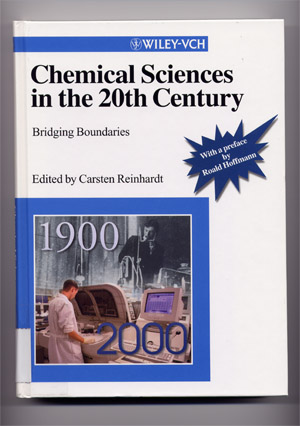 introduces :
introduces :C. Reinhardt (ed.)
Chemical Sciences in the 20th Century
Wiley-VCH, Weinheim, 2001
ISBN 3-527-30271-9
EUR 89.00 about $90.00
 introduces :
introduces :

Table of Contents
Foreword ................................................................ V
Roald Hoffmann
Preface ................................................................. IX
Christoph Memel
List of Contributors .................................................... XVII
Disciplines, Research Fields, and their Boundaries ...................... 1
Carsten Reinhardt
References and Notes .................................................... 13
1. Research Fields and Boundaries in Twentieth-Century Organic Chemistry ... 14
Peter J.T.Morris, Anthony S.Travis, and Carsten Reinhardt
1.1 Physical Organic Chemistry .............................................. 14
1.2 Physical Instrumentation and Organic Chemistry .......................... 20
1.3 Bioorganic Chemistry .................................................... 29
1.4 Conclusion .............................................................. 38
References and Notes .................................................... 38
Part I
Theoretical Chemistry and Quantum Chemistry
2. Theoretical Quantum Chemistry as Science and Discipline:
Some Philosophical Remarks on a Historical Issue ........................ 45
Nikos Psarros
2.1 The Quarrel of the Faculties ............................................ 45
2.2 Theoretical Quantum Chemistry: Establishing a New Science in the
Twentieth Century ....................................................... 46
2.3 Giovanni Battista Bonino: Pioneer of the New Science and Founder of a
New Discipline in Italy ................................................. 48
2.4 Jean Barriol: The French Version ........................................ 49
References and Notes .................................................... 50
3. Issues in the History of Theoretical and Quantum Chemistry, 1927-1960 ... 51
Ana Simoes and Kostas Gavroglu
3.1 Introduction ............................................................ 51
3.2 Re-thinking Reductionism or the Chemists' Uneasy Relation with
Mathematics ............................................................. 51
3.3 Convergence of Diverging Traditions: Physics, Chemistry, and
Mathematics ............................................................. 56
3.4 The Role of Textbooks in Building a Discourse for Quantum
Chemistry ............................................................... 62
3.5 The Ontological Status of Resonance ..................................... 64
3.6 The Status of the Chemical Bond ......................................... 68
3.7 The Impact of Computers in Quantum Chemistry: the Split of the
Community ............................................................... 70
References and Notes 72
4. Giovanni Battista Bonino and the Making
of Quantum Chemistry in Italy in the 1930s .............................. 75
Andreas Karachalios
4.1 Introduction ............................................................ 75
4.2 Early Career ............................................................ 76
4.3 Bonino and the Beginning of Infrared Spectroscopy in Italy .............. 77
4.4 The Scientific and Political Context .................................... 79
4.5 Scientific Contacts in Germany and Austria, 1931—1934 ................... 83
4.6 Early Contributions to Quantum Chemistry ................................ 86
4.7 Bonino's Place within Contemporary Research ............................. 89
4.8 The Advent of Group Theory in Bonino's Work ............................. 90
4.9 Bonino's Quantum Mechanical Concept of Coordination ..................... 92
4.10 Encroaching Political Developments ...................................... 94
4.11 Conclusion .............................................................. 98
References and Notes .................................................... 99
5. Between Disciplines: Jean Barriol and the
Theoretical Chemistry Laboratory in Nancy ............................... 105
Marika Blondel-Mégrelis
5.1 Inspirations ............................................................ 106
5.2 Mathematics ............................................................. 108
5.3 Quantum Chemistry ....................................................... 110
5.4 Pragmatism .............................................................. 111
5.5 Foundations ............................................................. 112
5.6 Experiment .............................................................. 114
5.7 Jean Barriol's Theoretical Chemistry .................................... 115
References and Notes .................................................... 117
Part II
From Radiochemistry to Nuclear Chemistry and Cosmochemistry
6. From Radiochemistry to Nuclear Chemistry and Cosmochemistry ............. 121
Xavier Roqué
6.1 Physical Evidence in Chemical Disciplines ............................... 122
6.2 Identification and Production ........................................... 124
6.3 Natural Versus Arfificial Elements ...................................... 126
6.4 Discipline Dynamics ..................................................... 127
References and Notes .................................................... 129
7. The Discovery of New Elements and the Boundary
Between Physics and Chemistry in the 1920s and 1930s.
The Case of Elements 43 and 75 .......................................... 131
Brigitte Van Tiggelen
7.1 Rhenium: A Success ...................................................... 132
7.2 A Failure: Masurium ..................................................... 137
7.3 A Comparison: From Hunting to Breeding .................................. 139
7.4 The End of a Research Tradition ......................................... 140
References and Notes .................................................... 142
8. The Search for Artificial Elements and the Discovery of Nuclear Fission . 146
Ruth Lewin Sime
References and Notes .................................................... 158
9. From Geochemistry to Cosmochemistry:
The Origin of a Scientific Discipline, 1915—1955 ........................ 160
Helge Kragh
9.1 Introduction ............................................................ 160
9.2 Nineteenth-Century Backgrounds .......................................... 161
9.3 Chemists, Element Formation, and Stellar Energy ......................... 164
9.4 Victor Moritz Goldschmidt and the Transition from Geo- to
Cosmochemistry .......................................................... 169
9.5 Geochemistry and the Shell Model of Nuclear Structure ................... 175
9.6 Chemistry in Space ...................................................... 176
9.7 Chemical Cosmogony and Interstellar Molecules ........................... 178
9.8 The Emergence of Cosmochemistry ......................................... 180
9.9 Conclusion .............................................................. 183
References and Notes .................................................... 183
Part III
Solid State Chemistry and Biotechnology
10. Between the Living State and the Solid State:
Chemistry in a Changing World ........................................... 193
Peter J. T. Morris
10.1 Biotechnology and the Myth of a Recent "Biotech Revolution" ............. 194
10.2 Polymer Science ......................................................... 195
10.3 At the Boundaries ....................................................... 196
10.4 A Composite Field of Research ........................................... 198
10.5 Conclusion .............................................................. 200
References and Notes .................................................... 200
11. Biotechnology Before the "Biotech Revolution": Life Scientists,
Chemists and Product Development in 1930s—1940s America ................. 201
Nicolas Rasmussen
11.1 Hormones: "Master Molecules" of Life Between the Wars ................... 203
11.2 Pharmaceuticals in Peace and War ........................................ 210
11.3 Conclusion .............................................................. 218
References and Notes .................................................... 224
12. Polymer Science: From Organic Chemistry to an
Interdisciplinary Science ............................................... 228
Yasu Furukawa
12.1 Macromolecular Chemistry as a New Branch of Organic
Chemistry ............................................................... 229
12.2 From Macromolecular Chemistry to Polymer Science: Staudinger, Mark,
and the Naming of a Discipline .......................................... 231
12.3 The Rise of Polymer Physics ............................................. 233
12.4 The Biological Nexus .................................................... 237
12.5 The Problem of Interdisciplinary Science ................................ 238
12.6 Polymer Science versus Macromolecular Science: Continuing
Strife .................................................................. 240
References and Notes .................................................... 241
13. At the Boundaries: Michael Polanyi‘s Work on Surfaces
and the Solid State ..................................................... 246
Mary Jo Nye
13.1 Polanyi on Scientific Ideals and Scientific Practice .................... 246
13.2 The Potential Theory of Adsorption, 1914—1932 ........................... 248
13.3 Diffraction and the Solid State ......................................... 250
13.4 Rewards and Recognition in the Scientific Community ..................... 252
References and Notes .................................................... 254
14. The New Science of Materials: A Composite Field of Research ............. 258
Bernadette Bensaude-Vincent
14.1 From Metallurgy to Solid State Physics .................................. 259
14.2 From Reinforced Plastics to Composite Materials ......................... 262
14.3 From Composite to Complex Structures ... Through Biomimetics ............ 266
14.4 A Future for Chemists? .................................................. 267
References and Notes .................................................... 269
Index ................................................................... 271
